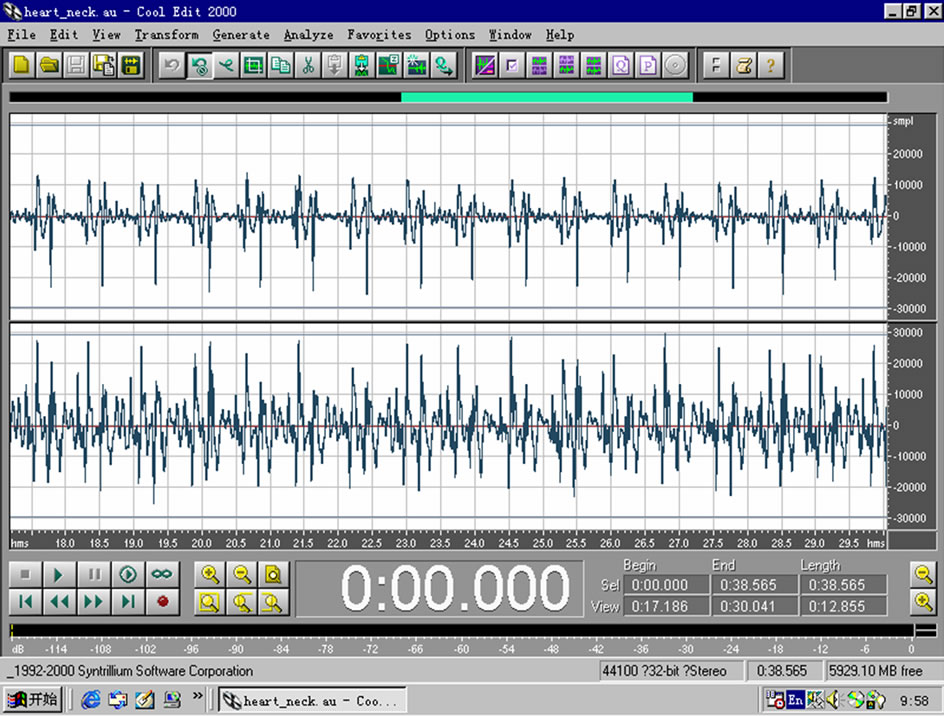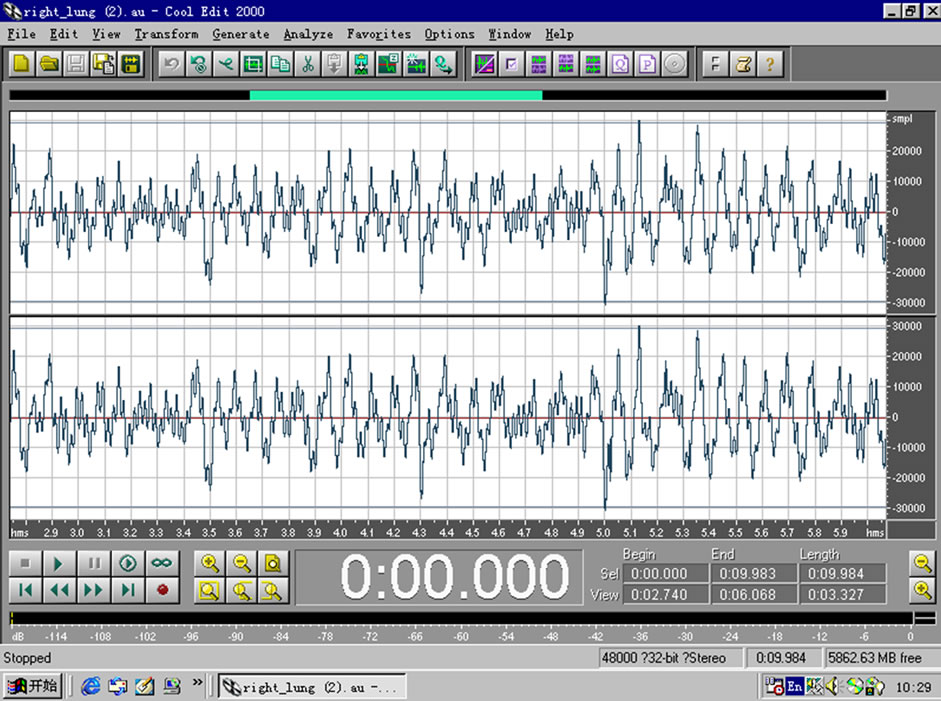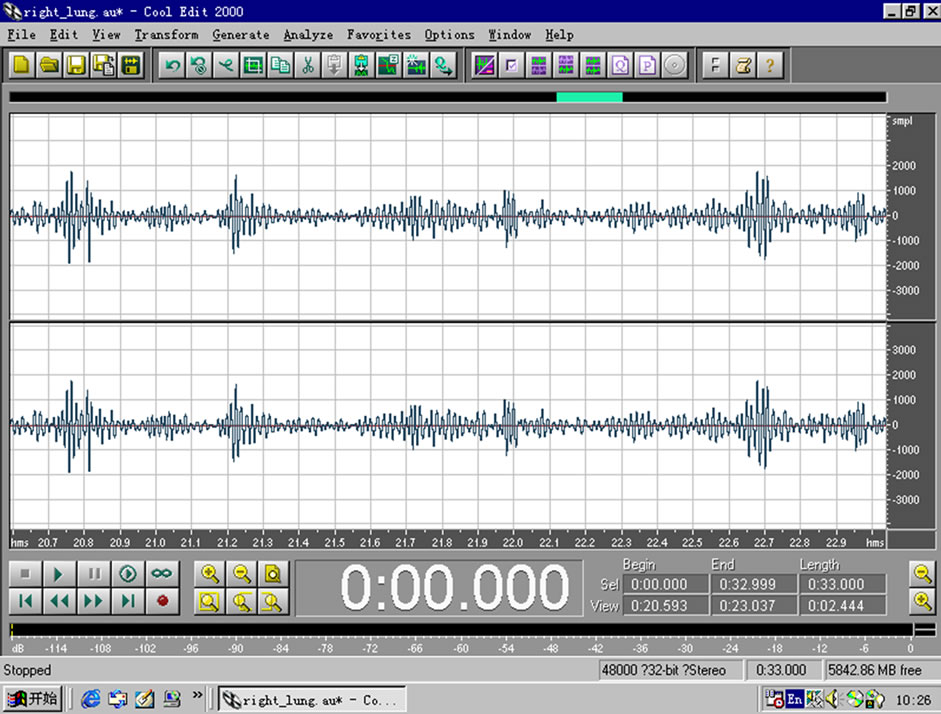Journal of Biomedical Science and Engineering
Vol.6 No.7(2013), Article ID:34185,5 pages DOI:10.4236/jbise.2013.67087
Development of a signal collecting system for double-channel auscultation
![]()
1Laboratory of Forensic Medicine and Biomedical Information, Chongqing Medical University, Chongqing, China
2School of Optoelectronic Information, Chongqing University of Technology, Chongqing, China
Email: *clc_mpd@163.com
Copyright © 2013 Qifeng Jiang et al. This is an open access article distributed under the Creative Commons Attribution License, which permits unrestricted use, distribution, and reproduction in any medium, provided the original work is properly cited.
Received 14 June 2013; revised 14 July 2013; accepted 21 July 2013
Keywords: Auscultation Signal; Sound Card; Music Processing Software; Analog Signal Processing Circuit
ABSTRACT
As is known to all, many auscultations of human body, such as heart, lung and carotid artery sound, play a major role in clinic. And their signal frequency is in the range that computer sound card can handle, so we can use analog-to-digital (A/D) conversion of sound card as A/D conversion (ADC) of auscultation signals, and double-channel auscultation signals (DCASs) can be input into personal computer(PC) by sound card that every computer has, and it makes the hardware design more simple. Because auscultation signals are input from sound card, any common music processing software (CMPS) can be used to process received auscultative signals, and it is not necessary to write special processing software for them. Therefore, only a double-channel and front-end analog signal processing circuit of auscultation is needed to be designed. By this method of constituting the signal collecting system for double-channel auscultation, it is simple and low cost, and needs no special software, so it has very important values and a broad market prospect.
1. INTRODUCTION
Traditional stethoscope, as you know, is still easily and widely used in clinic because auscultation, a kind of diagnostic method, plays a major role in clinic [1] and medical teaching [2-6]. Although traditional stethoscope has some advantages, such as simple structure, convenient use and so on, it has large extent subjectivity and low sensitivity for disease diagnosis. With computer’s development, a variety of special auscultation instruments, which base on multimedia technology, are appearing, and they avoid the subjectivity of ordinary auscultation instrument in a certain extent, and can make quantitative analysis. However, their functions are singleness and their price is high, and we cannot get auscultation of two parts simultaneously by them. But, in clinical, double-channel simultaneous auscultation has important clinical values, especially for some symmetrical parts, such as carotid artery and lung. In addition, their signal frequency is in the range that sound card of computer can handle, so we can use ADC of the sound card as the ADC of auscultative signals. And according to the situation of current auscultative instrument and the popularity of multimedia computers, we design a kind of auscultation instrument, which is low cost and can be used for auscultation of two parts at the same time.
By using two high precision audio sensors, doublechannel auscultation analog signals can be obtained and then input into our designed signal preprocessing circuit, whose output is connected to sound card of multimedia computer. By using A/D converter of sound card, double-channel auscultation analog signals may be converted to digital signals. Therefore, no special software is needed and CMPS can be used to analysis and process AS. Furthermore, their information exchange and consultation may also be carried out on line by internet. With the continuous development of corresponding software, functions of the music processing software will be enhanced continuously. For us, Cool Edit 2000, a music processing software, is selected to process and analyze DCASs in practice, because it has many functions, such as audio recording, playing, editing, digital filtering and spectrum analyzing. From above design, a doublechannel auscultation analysis system can be made by using only one signal collector and CMPS. So this system has many advantages, such as powerful function, low cost, easy use, and a broad market prospect. And it can be used at home as well as clinic and medical education.
2. SYSTEM STRUCTION
As is known to all, frequency of AS (such as signal of heart sound, lung sound and carotid artery sound of human), is in audio frequency range, which is just in range that computer’s sound card can handle, so sound card can act as auscultation signal (AS) data acquisition card. Obtained by auscultation sensor, DCASs are input into pretreatment circuit designed by us, and its output is input into computer from line input port of sound card. Then we can directly use sound card to complete ADC of DCASs and apply CMPS to process and analyze DCASs. Therefore, combined only with front-end analog signal pretreatment circuit of DCASs, this system can be realized with Windows software and multimedia PC acting as a platform.
From whole, this system includes two parts, hardware and software. Hardware consists of double-channel AS processing circuit (DCASPC) and PC. Software part only includes CMPS. And function block diagram of this system’s hardware is shown in Figure 1. Among them, auscultation sensors I and II are aimed to change doublechannel sounds to corresponding auscultative voltage signals separately. And preprocessing circuits I and II are used to amplify double-channel auscultative voltage signals and filter out interference signals for meeting input demands of sound card. After auscultative voltage signals are fed into to PC by line input port of sound card, PC can deal with AS and realize display, record and play, filter and save by CMPS. Moreover, pictures and information of AS may be sent to anywhere that internet can reach for doctor preliminary diagnosis. Following two parts, hardware and software, are described separately.
2.1. Hardware
Hardware of this collecting system includes three parts, auscultation sensor, preprocessing circuit and PC that is known for everyone. Moreover, PC is in hand and any PC can be used in this system. Among them, auscultation sensor and preprocessing circuit are designed by us. Therefore, it is necessary that only auscultation sensor and preprocessing circuit are decrypted. Because this system is parallel double-channel auscultation, two parts of hardware about every channel AS, which are auscultation sensor and preprocessing circuit, are same. So it is all right to descript one signal processing circuit of this signal collecting system. The following, shown in Figure 2, signal processing circuit of one channel auscultation is narrated in detail.
2.1.1. Auscultation Sensor
Made by us, auscultation sensor changes sound to electric signal. The auscultation sensor is composed of stethoscope head, flexible pipe and electret microphone, shown in Figure 3. Among them, stethoscope head and

Figure 1. Function block diagram of system.

Figure 2. Function block diagram of one channel AS processing circuit.

Figure 3. Auscultation sensor.
flexible pipe are corresponding tow parts of traditional stethoscope without any change. And electret microphone, which can be bought as a basic component, may transform acoustic vibration into electric signal. Therefore, it can completely realize changing acoustic vibration of auscultation into corresponding electric signal in this system. By home-made auscultation sensor, all kinds of auscultation signals can be converted to homologous electric ones. And the output of auscultation sensor is connected directly to next stage, preprocessing circuit.
2.1.2. Preprocessing Circuit
The primary goal of this circuit is to filter interference signals, gets suitable signal amplitude and avoids it too big or too small for ADCs integrated in sound card of computer. This circuit, shown in Figure 2, consists of preamplifier, 50 Hz trap filter and low pass filter unit. And then we introduce these three units in detail.
1) Preamplifier Unit The basic aim of this unit is to get AS with low noise. This unit is mainly composed of amplifier AD8539 [7] and its peripheral components. The AD8539 is very high precision amplifiers featuring extremely low offset voltage, low input bias current, and low power consumption. The supply current is less than 215 μA maximum per amplifier at 5.0 V. Operation is fully specified from 2.7 V to 5.0 V single supply (±1.35 V to ±2.5 V dual supply). It works well as a preamplifier due to its low input voltage noise of 50 nV/kHz at 1 kHz, 2 μVp-p in the 0.1 Hz to 10 Hz band, and the low input bias current of 25 pA max. And it has typical offset voltage of 5 μV, extremely small temperature drift of 0.1 μV/˚C, very low input bias current of 125 pA maximum, gain bandwidth of 430 KHz. So it is an ideal selection as preamplifier of AS. After processing of this unit, the enough amplitude signals can be acquired for next trap filter unit.
2) 50 Hz Trap Filter Unit To reduce 50 Hz frequency interference, this trap filter unit is designed and it is made up of amplifier AD8539, some resistors and capacitances, shown in Figure 4. There are many kinds of circuits of 50 Hz trap filter in practice. In order to get better effect and easier adjustment of 50 Hz frequency, the following filter circuit is selected. Because quality factor of this filter, whose value is 10 in practice, is easy to be changed by adjusting resistors that are marked RA, and the gain of the following circuit is also can be modified by resistor, RG. Moreover, in practice, the error of capacitances is large, and is about 20% normally, and it is convenient that the trap frequency of this circuit can be accurately adjusted to 50 Hz by resistor RF1 or RF2. After this unit, its output signal is transmitted to next part, low pass filter unit.
3) Low Pass Filter The main purpose of this unit, which consists of AD- 8639 [8] and its peripheral components, is to extract useful signal from front stage output and restrain interference. In this unit, accounting for frequent range of AS, active second-order low pass filter (LPF) is designed, and its’ cutoff frequency is 1000 Hz in circuit. This filter is realized by using AD8639, because it has typical offset voltage of only 3 μV, extremely small temperature drift of 0.01 μV/˚C, very low input bias current of 40 pA maximum, gain bandwidth of 1.5 MHz. After processing of this filter, AS has its own needed frequency bandwidth and is input into computer sound card. And then any CMPS may be applied to deal with AS.
2.2. Processing Software
Because AS is input into PC from sound car of computer, it can be handled by any CMPS in this collecting system. With development of CMPS, the ability will become more and more powerful. Finally, Cool Edit 2000, a music processing software, is chosen. It is one of the best music processing software on the market, and has strong processing functions of audio signal, such as digital filtering of arbitrary frequency range, comparing, splicing and spectrum analyzing of audio signal. And it is easy to obtain and measure physiological parameters of AS, such as heart rate, double-channel amplitude and frequency characteristics. By comparing several kinds of physiological parameters with each other, may important information may be obtained. In addition, this software can also playback any collected or disposed audio signals, therefore, it is very convenient for user, especially for medical students, to listen to one or several frequency auscultations and observe corresponding signal waveforms. And for some disease diagnosis, those have very important clinical value. In a word, this software can completely meet the demands of AS’s dispose and analysis.

Figure 4. Circuit of 50 Hz trap filter.
3. RESULTS AND APPLICATION
On the whole, this collecting system is easy to be operated, low cost, powerful, and can act as an affordable diagnostic tool in the clinical applications and medical teach. By this system, auscultation information can be objectively and truly recorded, and doctors can understand dynamic changes of auscultation information in the process of disease treatment. Using record and playback functions of this system, the auscultation signals may be displayed through the audio-visual style and it is easy to identify this confusing auscultation information, such as distinguishing the second heart sounds from the third. Through conveniently observing waveform and hearing relative sound of AS, relationship and regularity between them can be found. Furthermore, combined with waveform and original auscultation experiences in clinical, more information may be achieved and diagnosis accuracy of disease also is bound to be improved by this system. In addition, by this music software, all kinds of disposition, which includes spectrum analyzing, digital filtering, splicing and loop playing, may be carried out and it great helps to diagnosis of some diseases. At the same time, through a large number of clinical trials, some characteristics of signal waveforms and frequency spectrum about diseases auscultation can be analyzed out. Normal heart sound signals that acquired by this system are very similar between original and after filtering. And the waveform differences between the first and second heart sounds are very clear and their sounds also are very obvious. In addition, according to the recorded AS of patients with pacemaker, the moment stimulated by it can be clearly seen from signal waveform and its’ sound also can be listened out easily. Certainly, some features of AS about different patients, such as atrial fibrillation, rheumatic heart disease, can be found out.
It is worth pointing out that the outstanding advantages of this system is able to simultaneously collect AS of two organs or two parts of the same organs for recording, comparing, signal processing and analyzing, and provides more valuable information for doctors. Especially in some symmetrical parts, such as left and right carotid artery, left and right lungs, processing and analyzing AS is more valuable. For example, through difference of peak moment between heart and carotid artery AS can indirectly reflect blood flow situation in the vessel. In Figure 5, two original AS waveforms of normal

Figure 5. Original AS waveforms of normal carotid and heart artery.
heart and carotid artery are shown. From this chart, the heat rate is easy to be estimated. After digital filtering by this software, signal waveforms of the first and second heart sounds, which are shown in bottom of Figure 6, are very clear. In Figure 7, two original AS waveforms of right lung about rheumatic heart disease are shown by double channels at same time. From this, its waveforms are seemed to be disordered, but after digital filtering, signal waveforms, shown in Figure 8, are some rules. All those indicate that this collecting system has some important clinical value in certain diseases diagnosis.
In addition, diagnostic accuracy of traditional stethoscope has relationship with the doctor’s experience, and this is inconvenience for auscultation teaching. By using the functions of this collecting system, such as record, paste, contrast, and loop play, we can splice and edit many auscultation signals of typical diseases for teaching. In education, those auscultation signals can be played repeatedly for medical students, and this makes medical auscultation teaching more vivid and medical students master clinical auscultation skills more easy. Furthermore, through Internet transmission, online remote distance learning also can be realized. In a word, this collecting system is cheap and easy to be made, so it can be widely used in the teaching about medical auscultation for medical college, university and hospital.
4. DISCUSSION AND CONCLUSION
This system makes good use of PC sound card to complete A/D conversion and CMPS to process AS, and breaks through traditional model that the medical instruments must use dedicated A/D card and special application software. Thus the cost of hardware and software about double-channel auscultation signal acquisition and dispose is greatly reduced, and a new way is afforded for the digital double-channel medical auscultation diagnoses and teaches. Moreover, Windows operation system

Figure 6. Processed AS waveforms of normal carotid and heart artery.

Figure 7. Original AS waveforms of right lung about rheumatic heart disease.

Figure 8. Processed AS waveforms of right lung about rheumatic heart disease.
may support multiple sound cards and multi-channel sound signals processing software, such as Cool Edit Pro, so this system is easy to upgrade to multi-channel auscultation signal processing system. At the same time, the medical diagnostic accuracy of this system may also be constantly improved with development of technology about hardware and software of sound card. Certainly, by using the method of this collecting system, doublechannel auscultation function is easy to add to all-pervading PC because Cool Edit 2000 has friendly user interface, simple operation and is easy to learn. Although this system is superior to the traditional auscultation method and also can realize remote auscultation and education, it is limited to auscultation of audio range. If we want to expand the system into lower and higher frequency range, higher performance sound card must be needed.
REFERENCES
- Huang, X.-D., Yan T. and Chen H. (2013) Development of wireless electronic isothermal stethoscope head. China Medical Devices, 28, 31-32.
- McKinney, J., Cook, D.A., Wood, D., et al. (2012) Simulation-based training for cardiac auscultation skills: Systematic review and meta-analysis. Journal of General Internal Medicine, 28, 283-291. doi:10.1007/s11606-012-2198-y
- Simon, E.L., Lecat, P.J., Haller, N.A., et al. (2012) Improved auscultation skills in paramedic students using a modified stethoscope. The Journal of Emergency Medicine, 43, 1091-1097. doi:10.1016/j.jemermed.2012.01.048
- Shen, C.-H., Choy, F.K., Chen, Y. and Wang, S.Y. (2013) A modular approach to computer-aided auscultation: Analysis and parametric characterization of murmur acoustic qualities. Computers in Biology and Medicine, 43, 798- 805. doi:10.1016/j.compbiomed.2013.01.008
- Li, Q.Z. and Qin, Y. (2013) The experience in clinic teaching for general practitioners in cardiac auscultation. China Modern Medicine, 20, 146-148.
- Shen, Y.-C. and Tuo, X.-L. (2012) Application of heartlung simulative auscultation on general practitioner’s incumbency train. Journal of Jianghan University, 40, 100- 102.
- Analog Devices (2013) Low power, precision, auto-zero op amps AD8538/AD8539. http://www.analog.com/static/imported-files/data_sheets/AD8538_8539.pdf
- Analog Devices (2013) Low power, precision, auto-zero op amps AD8638/AD8639. http://www.analog.com/static/imported-files/data_sheets/AD8638_8639.pdf
NOTES
*Corresponding author.

